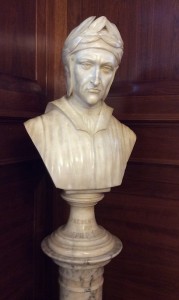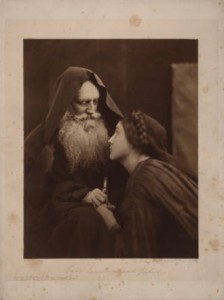
The bust of Dante, given to Baylor by Joseph P. Todaro of Temple, Texas, is on display in the Research Hall of the Armstrong Browning Library.
By Colby Henderlite, ABL Graduate Assistant
On 15 June 1922, Baylor honored the 600th anniversary of the death of Italian poet Dante Alighieri with a public event. To celebrate, Baylor held a ceremony which not only honored the poet but also included speeches and gifts to the University. Baylor’s celebration was one of many held around the world to remember the great poet. Politicians from across the United States, including President Warren G. Harding and Secretary of State Charles Evans Hughes, sent greetings and tributes to Dante to be read during the ceremony at the request of Dr. A.J. Armstrong, chair of Baylor’s English Department and organizer of the event (“Dante Sei-Centennial Will Take Place at Baylor June 15”).
The ceremony included a speech by American poet and lecturer Richard E. Burton. It also included the presentation by Joseph P. Todaro, a Temple, Texas, businessman, of a bust of Dante to the University. Todaro, a native Italian, gave the bust to Baylor as a thank you gift to Dr. Armstrong who had helped him study English.
During the presentation of the bust, Todaro said, “I am most happy to be the means of securing and presenting this marble bust of the poet to this University as a token of my sincere friendship” (Todaro). The Carrara marble bust was made to resemble the famous statue of Dante in the Piazza di Santa Croce in Florence, Italy. Baylor President Samuel Palmer Brooks accepted the gift on behalf of the University. Along with the bust, the Waco Tribune noted Todaro’s gift of a rare illustrated copy of Dante’s Divine Comedy “in handsomely embossed leather binding” (“Dante Sei-Centennial Will Take Place at Baylor June 15”). The bust, donated to Baylor on this day 93 years ago, is on display in the Research Hall of the Armstrong Browning Library.
Sources
“Dante Sei-Centennial Will Take Place at Baylor June 15.” Waco Tribune 11 June 1922. Print.
Lewis, Scott. Boundless Life: A Biography of Andrew Joseph Armstrong. Waco, Texas: Armstrong Browning Library of Baylor University, 2014. Print.
Todaro, Joseph P. Signed typescript of speech by Joseph P. Todaro. Baylor University. Waco, Texas. 15 June 1922.




